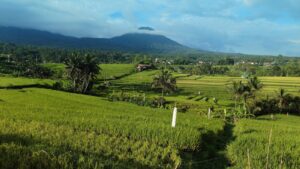Bali’s New Permit Freeze: How Floods Are Forcing a Turning Point for Land Conversion Policy
Bali has announced a key shift in policy: starting in 2025, no new permits will be issued for hotels, restaurants, or commercial developments on productive land, particularly rice fields, as part of its 100-year plan to mitigate flood risk and preserve agricultural zones. This article explores how that change affects investors, developers, farmers, and local communities; why resilience and sustainable land policy are becoming central to Bali’s future; and how market players can turn regulatory constraints into competitive advantage. For property advocates and marketers, the freeze on land conversion is not just a hurdle, it is a chance to lead with purpose.
In response to the deadly flash flooding of September 2025 that left at least 18 people dead, Bali has moved to block new hotel and restaurant permits on productive land, including its iconic rice fields, as part of Governor Wayan Koster’s plan to stop land conversion for commercial use. This step, aligned with Bali’s 100-year plan, flags a major shift in how tourism, agriculture, environment, and planning will be balanced going forward. For property advocates, developers, local farmers, and investors, this is a pivot moment.
 On 10 September 2025, Bali declared a state of emergency after severe flash flooding, largest in more than a decade.
On 10 September 2025, Bali declared a state of emergency after severe flash flooding, largest in more than a decade.- Rivers burst banks, at least 112 neighborhoods submerged, nine cities/districts affected.
- After assessment, the Bali provincial government, with support from Indonesia’s environment ministry, announced it will stop issuing permits for hotels, restaurants, or other commercial facilities on “productive land,” especially rice fields.
- Exemptions or selective permissions may remain for private residences, dependent on stricter spatial planning and environmental review.
Resilience Through Land Policy
Many commentators have focused on overtourism, loss of rice fields, environmental damage. But I want to bring in an angle less-discussed: resilience. By resilience, I mean how well Bali can withstand shocks heavy rainfall, flooding, climate change, infrastructure stress and bounce back. Land use policy is emerging as a front-line tool for resilience.
Productive Land & Natural Buffers
- Rice fields and agricultural terraces (such as the subak system) act like natural soak basins, slowing rainwater, absorbing flows that otherwise become flash floods.
- When rice fields are converted to impervious surfaces, hotels, villas, restaurants, runoff increases, drainage systems are overwhelmed, erosion and sedimentation rise. These degrade riverbeds and reduce capacity to carry water safely.
Climate Change & Increased Rainfall Intensity
- Experts warn that climate change is increasing the frequency and intensity of heavy rainfall events. What once were rarer storms are becoming more common. Bali’s rainy season (September-March) is when risk is already higher.
- Also, upstream deforestation (forest loss), changing watershed health, and urban expansion without adequate drainage or waste removal magnify flood risks.
Policy & Spatial Planning as Opportunity
- Bali’s 100-year plan is meant to align long-term land use, climate, tourism, agriculture, for sustainability. Blocking new commercial permits on productive land is one lever in that plan.
- There is an opportunity to reimagine tourism development: more sustainable, lower footprint, integrated with natural systems, use of buffers, green infrastructure (wetlands, retention basins, permeable paving).
Impacts & Opportunities by Stakeholder
Here’s how this shift affects different groups, and what opportunities or strategies they might consider.
| Stakeholder | Impact of Permit Freeze / Land Conversion Ban | Opportunities & Strategies |
|---|---|---|
| Local Farmers / Agricultural Communities | Protection of productive land, less risk of displacement; better protection of subak systems. | Could partner with tourism in agri-tourism; get support or compensation for services (flood mitigation, carbon sequestration). |
| Developers & Investors | Reduced availability of land in certain zones; need to rethink projects; higher risk if acquisition done without due diligence. | Pivot toward redevelopment of non-productive land; adaptive reuse; brownfield; sustainable design; collaboration with government on spatial plans. |
| Local Governments (Regencies, Districts) | Need to enforce new regulations; possibly pushback from tourism sector; balancing growth vs environment. | Develop robust spatial plans; enforce environmental review (AMDAL in Indonesia); invest in infrastructure (drainage, waste management, river basin health). |
| Tourism Businesses | May see constraints on expansion; some planned hotels/villas may no longer get permits. | Shift to sustainable tourism; boutique stays, eco lodges; emphasize quality over quantity; integrate with local agriculture; market resilience and ecological cred as a differentiator. |
| Environmental NGOs / Civil Society | A win for conservation/advocacy; platform to push for stronger policy, enforcement. | Monitor compliance; engage in public awareness; promote nature-based solutions; work with scientists on flood risk mapping. |
| Property Advocacy / Real Estate Sector | Permits risk; changing land values; new risk mapping needed; possible slower growth in areas previously open. | Update advisory to clients; survey land use zones; shift investments; position properties with green credentials; anticipate regulation and factor into valuation. |
Risks & Challenges Ahead
While this policy move is positive in many respects, it is not without challenges. Possible pitfalls include:
- Enforcement Gap
Laws on the books are one thing; enforcing many, many small projects, especially in remote areas or via informal structures, is another. Without strong regulatory oversight, “permit freeze” may be circumvented. - Compensation / Livelihood Effects
Farmers or landowners who expected to sell or convert land might lose value; how those changes are managed matters socially and economically. - Infrastructure & Waste / Drainage
Even with land conversion restrictions, existing drainage/waste systems may be inadequate. Flooding is rarely caused only by land conversion; often by clogged drains, insufficient river maintenance, waste accumulation. - Spatial Planning & Zoning Ambiguity
Need clear maps, definitions: what counts as “productive land”? Who determines boundaries? What about mixed-use zones? What about lands already permitted but under construction? - Tourism Economy Pressures
Bali’s economy depends heavily on tourism. Businesses may push back, seeking exemptions. There may be short-term loss of investment/revenue. - Legal / Regulatory Uncertainty
If rules change mid-planning, projects already started may get stuck. Investors may demand clarity on grandfathering of approved projects, transitional policies.
What Should Property Advocates & Marketers Do Now?
Because you asked for help in lead generation, promotion, marketing, and sales, here are tactical suggestions in light of the new policy shift:
- Audit available land: Identify parcels already zoned commercial but not “productive land”, or former non-agricultural land, suitable for hotel/villa development. Highlight these in your offerings.
- Promote sustainable & resilient development: Projects that respect natural water flows, integrate green infrastructure, preserve subak systems will have regulatory advantage and marketing appeal.
- Educate clients: Many property investors (domestic, foreign) may be unaware of the changes. Create content (blog, white paper, seminar) that explains what “productive land ban” means, risk mapping, approvals.
- Build alliances: Work with local government, environmental bodies, agricultural stakeholders to ensure projects are viewed favorably, or to co-develop land use plans that balance growth + conservation.
- Highlight value of proximity to green or agricultural buffer zones: Properties near protected rice fields, green belts, or near natural waterways, if well designed, can be positioned as premium resilience-oriented investments.
- Leverage digital marketing: Use SEO content about “land conversion ban in Bali”, “best places to invest now in Bali 2025/2026”, “agri-tourism opportunities Bali” to attract clients concerned about sustainable investments.
Using the Policy Change as a Sales & Branding Advantage
Rather than viewing the land conversion ban simply as a restriction, property companies and marketers can turn it into a branding and positioning asset:
- A project or brand that makes it clear it does not convert productive land, that uses existing structures or less-sensitive zones, can appeal to both domestic and international investors or buyers who care about sustainability, environment, climate risk.
- Packaging “green certifications”, “flood risk assessments”, and commitment to preserving agricultural landscapes can become a differentiator. For example, a villa development could offer “rice-field views preserved”, low-impact waste/drainage design, and maybe donate to subak restoration funds.
- Creating content that tells the story, showing before & after, demonstrating how policies are shifting, how local communities benefit, can build trust and premium perception.
Broader Implications & Future Scenarios
To see how this might unfold, here are some possible mid-term futures, plus what to watch for:
| Scenario | Likely Developments | What to Watch / Early Signals |
|---|---|---|
| Strict enforcement, new spatial plans fully enforced | Rapid decline in permit approvals on agricultural land; developers focus on cluster zones; greater investment in infrastructure; property values shift. | New bylaws published; mapping of “productive land” made public; enforcement actions (fines, stop orders); shifts in investor behavior. |
| Partial implementation / many exemptions | Some commercial projects still granted under loopholes; developers push lobbying; unpredictable regulation. | Reports of permits still being issued for tourism projects on rice fields; community complaints; legal challenges. |
| Tourism sector adapts / shifts market | Emergence of more eco-lodges, slower growth but higher quality; tours, hospitality emphasizing sustainability; domestic tourism more promoted. | New hotel/villa offerings with green branding; demand for protected zones; shift in foreign investor preference. |
| Flood risk remains/increases | Without unseen infrastructure and water-management investments, risk of recurring disasters; public pressure grows. | More flooding events, environmental damage; media coverage; possibly forced evacuations or insurance losses. |
This policy freeze on commercial land conversion in Bali may seem like a constraint to growth, but it also marks a clear signal: the era of unchecked tourism expansion is being reined in. What is emerging instead is an opportunity to craft a more resilient, environmentally integrated tourism and property model—one that respects rice fields, protects natural drainage, works with flood patterns and climate realities. For all stakeholders, farmers, investors, developers, marketers, this is a chance to lead, not just follow. Because Bali’s promise lies not only in what is built, but where, how, and how well we protect what we still have.





